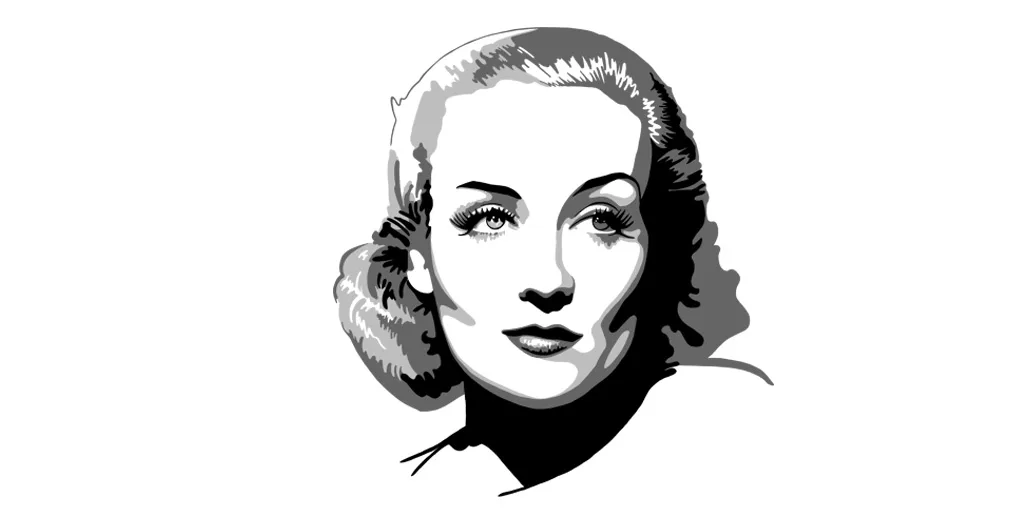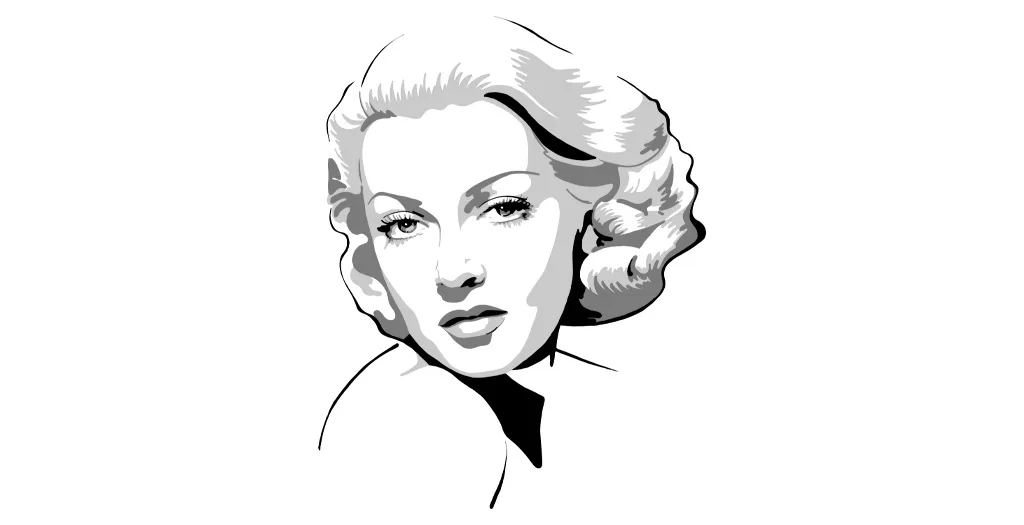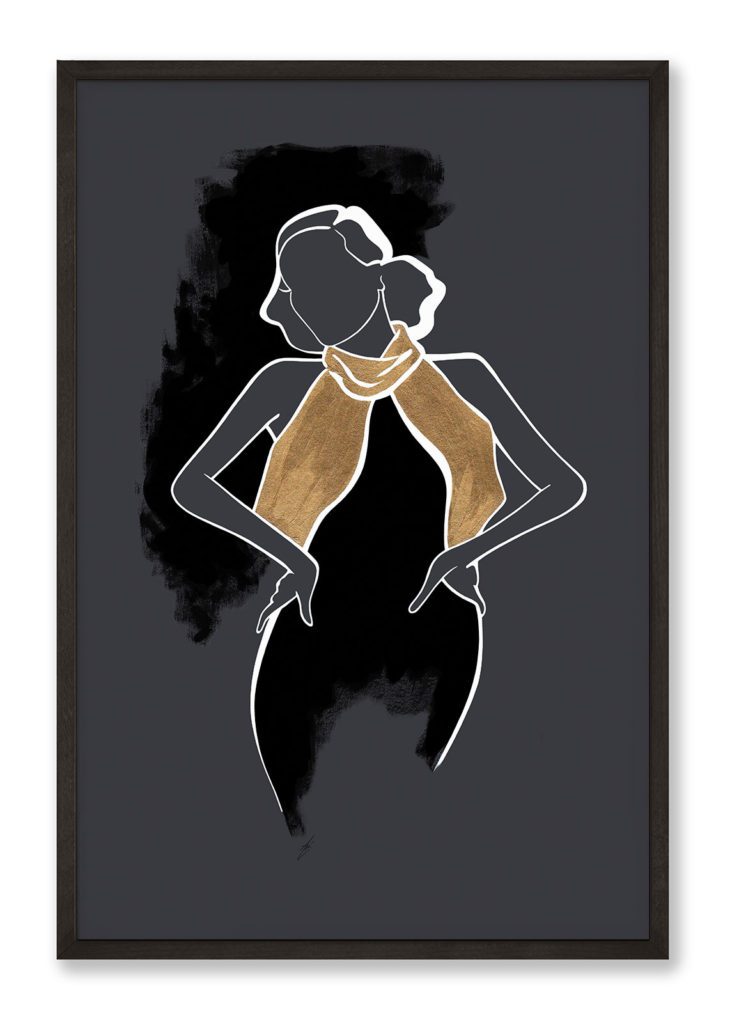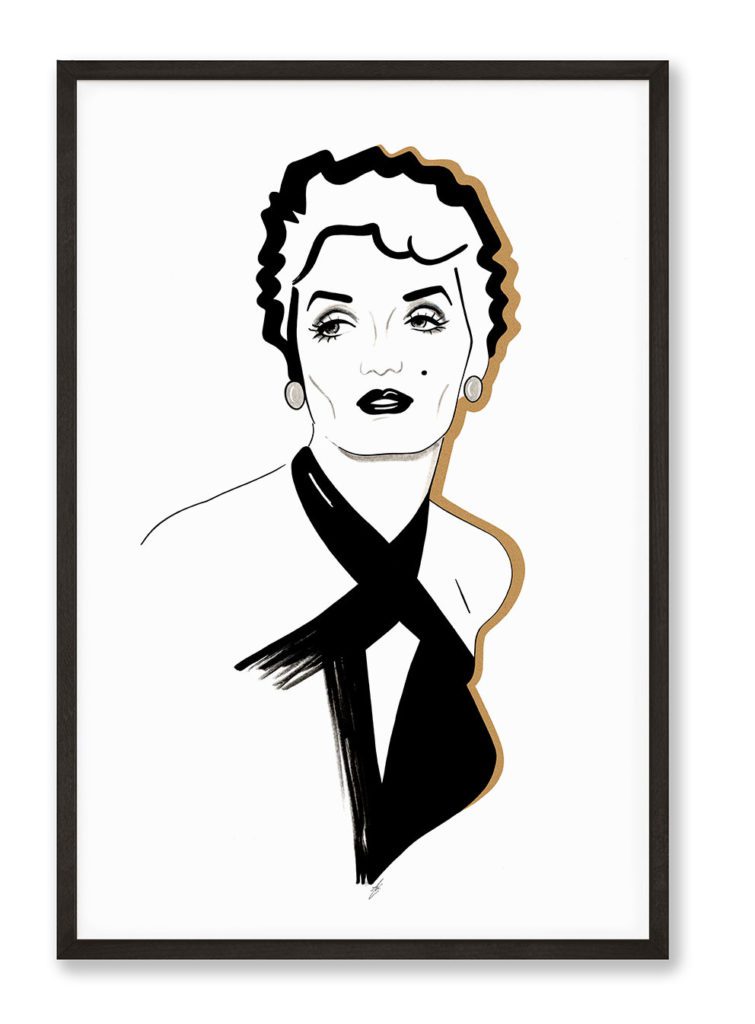Bette Davis
Fierce, strong-minded and opinionated


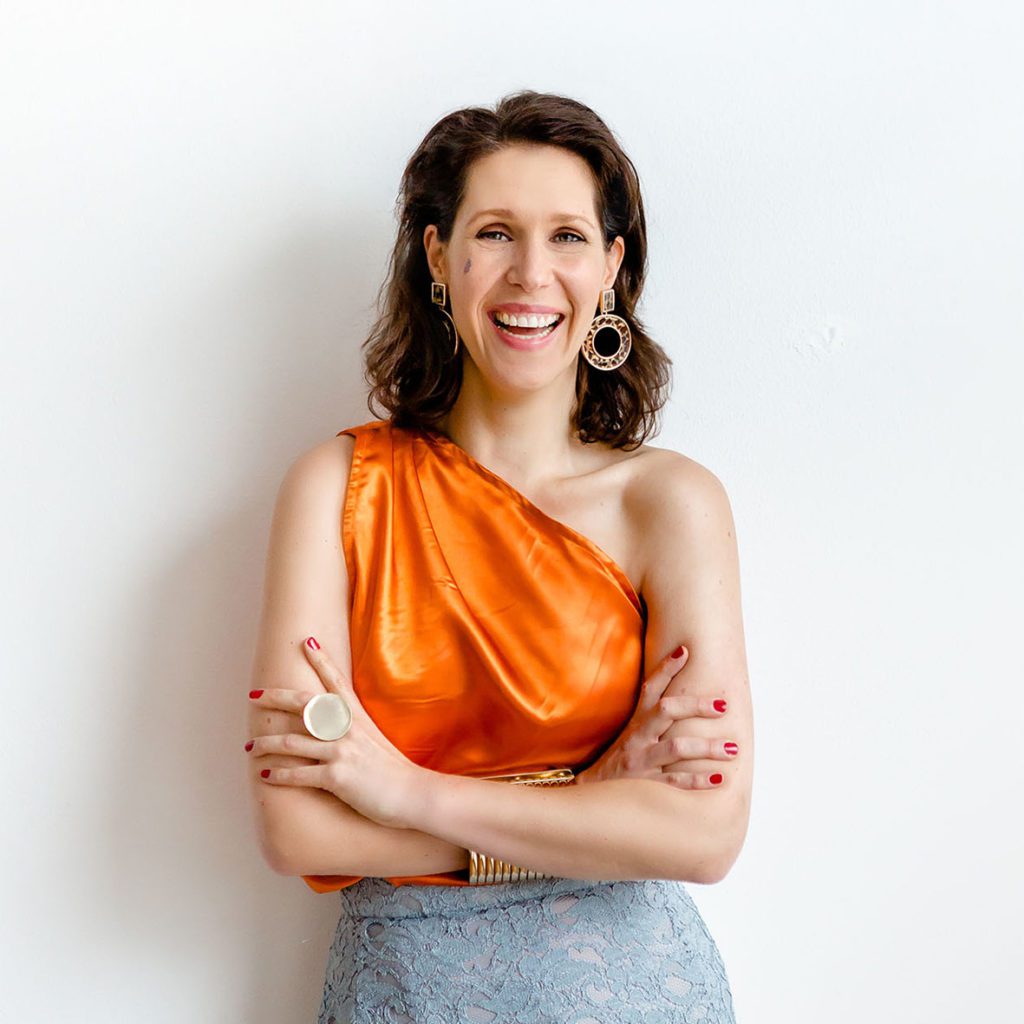

Hi, I'm Kate!
What I am most passionate about is to inspire you to see that your life is your own and biggest masterpiece.
Bette Davis was one hell of a woman and one of the 25 most important actresses of Classic American Cinema. She was the first actresses to receive 10 Academy Award nominations and won two of the statues in the end. Her feud with Joan Crawford made headlines for years and her love life was just as interesting as her career. Her trademarks were her mesmerizing eyes – that even inspired a 1980s hit – and her chain-smoking habit.
LISTEN TO THE PODCAST
SUBSCRIBE TO THE PODCAST
Beginnings
Ruth Elizabeth Davis was born on April 5, 1908 in Lowell, Masschusetts. She changed her nickname „Betty“ to „Bette“ in honor to Honoré de Balzac’s novel „The Cousin Bette“, with an „e“ at the end. Her father was a patent attorney in Massuchesetts and divorced mother Ruth August when the kids were still young. At age 8 Ruth and her younger sister Barbara Harriet were enrolled in a spartan boarding school and later at Cushing Academy. In 1921, the family moved to New York into an apartment on Broadway, when the mother used the tuition money of her daughters to enroll herself into the Clarence White School of Photography. Subsequently she worked as a portrait photographer. In NYC, Bette would attend the Robert Milton School of Theatre and Dance alongside classmate Lucille Ball – two ladies that I actually wouldn’t have pictured together.
In New York, Bette became also a Girl Scout, something that definitely had an impact on her and her leading style and the way she interacted with people – although that is my opinion only.
In 1926, Bette saw a production of The Wild Duck by Henrik Ibsen and it was leading lady Peg Entwistle that inspired Bette to audition with Eva Le Gallienne to be a student at her theater. But Le Gallienne was not convinced of Davis and her attitude. She even called her „insincere“ and frivolous“.
Instead, she got an engagement by George Cukor’s stock theater company for one week. After performing in Philadelphia, Washington and Boston, she finally made her Broadway debut in 1929, at age 21 in „Broken Dishes“ and followed it up with a role in the play „Solid South“.
Start in Hollywood
In 1930, at age 22, inspired by Mary Pickford’s role in „Little Lord Fauntleroy“, Bette Davis moved to Hollywood to screen-test for Universal Studios. Accompanying her on the train was mother Ruth. When she arrived in LA, a trying time was ahead of her. First, nobody was there to meet her – the Universal employee left because he didn’t see anyone fitting the description of an actress or a starlet. Next, she failed her screen-test. Another screen-test in 1931 for „A House Divided“ also failed. Head of Universal Studios Carl Laemmle actually considered letting Bette Davis go – but Karl Freund, a cinematographer, backed Bette up, pointed out her great eyes and that she would be perfect for the movie „Bad Sister“. And this is exactly the movie Bette Davis made her screen debut in. But, the movie was not a success, neither was the next, „Seed“, in which Bette’s role was too small to catch any attention from critics or audiences. After a series of other unsuccessful movies, Universal did not renew her contract. Davis was already preparing to go back to New York, went George Arliss, producer, director and actor, chose Davis to star in the movie „The Man Who Played God“ opposite himself for Warner Bros. And this is when Davis’s star started to rise and shine. The Saturday Evening Post about her performance: “She is not only beautiful, but she bubbles with charm.“ This movie got Davis a 5-year contract with Warner Bros and she would stay at the studio for the following 18 years.
First taste of stardom
After starring in about 20 movies of more or less critical acclaim, Davis finally landed the leading role of a prostitute in „Of Human Bondage“ in 1934 based on a novel by W. Somerset Maugham. Several actresses had turned down the role because it was an unsympathetic character and they feared for her image – Bette on the other hand loved the challenge and the chance to show off the range of her acting. This was also the first time Bette Davis was partnered with Leslie Howard, which later got her on board for „The Petrified Forest“ with Humphrey Bogart in 1936. The critics went wild about „Of Human Bondage“ and Life magazine wrote: „(…)probably the best performance ever recorded on the screen by a U.S. actress.“ Nevertheless, Davis was not nominated for an Academy Award – much to the surprise of fellow actors and actresses. It was Award nominee Norma Shearer that started a campaign to get Davis nominated. This led to the one and only time that the Academy allowed the consideration of an actor or actress that has not been officially nominated for an award. This actually led to a change in the voting system that has since been supervised by Price Waterhouse. When it comes to the Academy Award, Bette Davis confirmed that it was she that gave the Academy Award of Merit its nickname „Oscar“ as its butt resembled that of her husband, whose middle name was Oscar. Although the Academy maintains that it was the Academy’s executive director Margaret Herrick who coined the name as the statue resembled her uncle Oscar. I rather go with Bette’s version – much more entertaining.
Success
Bette Davis continued her rise to Hollywood stardom with Marked Woman in 1937 and Jezebel in 1938. The latter did not only get her a second Academy Award but also the speculation of getting the part of Scarlett in „Gone with the wind“. Although audiences favored her for the role, David O. Selznick did not think she was suitable, so the role went to Vivien Leigh instead, who received an Oscar for her performance. With „Jezebel“ was the beginning of the most successful phase of Bette Davis’s career.
„Dark Victory“ with co-stars Ronald Reagan and Humphrey Bogart, „The Old Maid“, „Juarez“ and „The Private Lives of Elizabeth and Essex“ followed. The last was her first color movie. She dug fully into the role and even shaved her hairline and eyebrows to resemble the English ruler. During the filming fellow actor Charles Laughton said the following words to her that would inspire her for the rest of her life: „Never not dare to hang yourself. That’s the only way you grow in your profession. You must continually attempt things that you think are beyond you, or you get into a complete rut.”
By that time, Bette Davis was Warner Bros. most bankable star and her role and the way she was filmed was considered with great care. „All This, and Heaven Too“ as well as „The Letter“ were critically praised and solid box office hits.
Hollywood Canteen Years
Bette Davis and fellow actor John Garfield were the driving force for bringing the Hollywood Canteen to life – with the help of 42 unions and guilds in the entertainment industry and thousands of celebrity volunteers. Davis served as president of the Canteen until the end of the war and would receive the Distinguished Civilian Service Medal for her work. The Hollywood Canteen was serving food and entertainment for soldiers during WWII.
The war years also led Bette Davis to star in other movies than she usually would have. The audiences were looking for more light-hearted and romantic material – thus she starred in such movies like „Now, Voyager“, „Watch on the Rhine“ and „Thank your Lucky Stars“.
Hollywood Decline & Freelancing
After some profitable movies, including „Mr. Skeffington“ and „The Corn is Green“, Davis’s movies began to lose money as well as praise from the critics. Her final movie role for Warner Bros. Was “Beyond the Forest“ in 1949 and Hedda Hopper wrote about it: “If Bette had deliberately set out to wreck her career, she could not have picked a more appropriate vehicle.“
After that, Bette Davis became a freelance actress. In 1951, she starred in „All About Eve“, the role which Claudette Colbert had yearned to play but was unable to because of her back injury. „All About Eve“ was a massive success and Davis got nominated for and won several awards at the Cannes Film Festival, the New York Film Critics Circle Award as well as the San Francisco Film Critics Circle Award. She was also asked that year to leave her hand prints in the forecourt of the Grauman’s Chinese Theatre.
TV
Most of Bette Davis’s movies from the 1950s were unsuccessful as was her Broadway revue „Two’s Company“. So, Bette Davis tried television, her first appearance was in 1956 on General Electric Theatre with subsequent roles on Wagon Train, a popular NBC western in 1959 and 1961. She followed them up with a Perry Mason episode in which she covered for Raymond Burr during his convalescence from surgery in 1962 as well as with an appearance on the TV western „The Virginian“. Hungry for more film work, she placed an ad in Variety magazine that read: „Mother of three – 10, 11, & 15 – divorcee. American. Thirty years experience as an actress in Motion Pictures. Mobile still, and more affable than rumor would have it. Wants steady employment in Hollywood. (Has had Broadway.)“ It actually got her back into the headlines and her comeback lasted several years.
Late Success
One of her late success was „Whatever happened to Baby Jane?“ Probably one of her most famous movies even to those only slightly interested in Old Hollywood movies. In this movie, as outlined in my episode on Joan Crawford, Davis and Crawford play sisters with Davis being a former child star and Crawford portraying an accomplished film actress, who now have to share a mansion. The film was heavily promoted with the Crawford-Davis feud that had the magazines gossiping away. Of course, the movie became a massive success and got the careers both of Crawford and Davis back on track.
The sequel „Huch … Hush, Sweet Charlotte“ was filmed without Crawford, but with a veteran cast that included Joseph Cotton, Mary Astor, Agnes Moorehead and Olivia de Havilland. The movie was also a success.
In the 1970s, Davis was part of a stage presentation in New York City called „Great Ladies of the American Cinema“ – along with her, Myrna Loy, Rosalind Russell, Lana Turner, Sylvia Sidney and Joan Crawford answered questions from the audience. Bette Davis took this format to Australia and the UK called „Bette Davis in person and on film“ – of course, a success. Other than that, she filmed some pilots that never made it to sitcom and supporting roles in a variety of movies.
She got back into demand, when receiving the American Film institute’s Lifetime Achievement Award and again in 1981, when Kim Carnes sung „Bette Davis Eyes“, which became a worldwide hit and the best-selling record of 1981.
She continued her work on television. I was especially excited to read that she filmed the pilot episode of the television series „Hotel“ in 1983 – I have watched this series and I loved it. Connie Sellecca was my idol! By the way: Anne Baxter, lifelong friend of Bette Davis, was also part of the cast.
Declining Health and Death
Just when Davis filmed Hotel, she was diagnosed with breast cancer and got a mastectomy, within two weeks of the surgery, Davis had four strokes that left her left side paralyzed and slurred her speech. It took several months for her to gain partial recovery. But, still, even at an old age, Bette Davis smoked up to 100 cigarettes a day.
In the following years, she appeared often in talk shows, with the likes of Larry King, Joan Rivers, and Davis Letterman. People loved to see her and listen to her being bitchy and feisty.
Bette Davis collapsed during the American Cinema Awards in 1989 – the cancer had returned. She recovered enough to travel to Spain, but her health deteriorated rapidly. She got rushed to France, to the American Hospital in Paris and died on October 6, 1989 at 81 years old.
She was interred in Los Angeles with mother Ruthie and sister Bobby. Her tombstone reads „She did it the hard way“, a comment Joseph L. Mankiewicz made about Bette shortly after filming „All About Eve“.
Feuds
Miriam Hopkins – Bette Davis was paired with Miriam Hopkins for the 1943 movie „Old Acquaintance“ and constantly felt that Hopkins tried to upstage her. Apparently, there was intense tension, competition and animosity between the two actresses. And apparently, Davis did not hold back when the script ordered her to shake Hopkins.
Warner Bros. – When Bette was becoming a star, she was starting to make star demands. She wanted to film „Mary of Scotland“ for RKO, but Warner Bros refuse. Instead, they chose „God’s Country and the Woman“ as her next movie. But, stubborn Davis did not want to do this movie and when production started she refused to work – instead she demanded an increase of salary on her contract. She was earning $1,250 at that time and was offered double that amount. But again, she refused. She demanded $3,500 a week, which today would be roughly $77k today, when corrected for inflation. On top of that she was asking for all rights to make outside pictures. While production on the Warner Bros. movie was halted, costs for the studio increased as it was shot in Technicolor and all cameras were on loan only. Thus, the studio eventually replaced Davis with Beverly Roberts. On top of that Davis, in the middle of this dispute, went on vacation to Britain with her husband. But, although claiming it was a vacation, she signed a contract with a British production company set to make a movie with Maurice Chevalier for a $50k salary. Warner Bros. Filed a lawsuit for breach of contract and eventually won – because the court didn’t see any other reason for Davis than greed and want for more money. Davis had to pay a fine to Warner Bros. and cover all legal fees. The press had a field day calling her overpaid and ungrateful in the process.
Robert Montgomery – Montgomery was Davis’s co-star in „June Bride“ in 1948 and she later described him as “a male Miriam Hopkins… an excellent actor, but addicted to scene-stealing”
Joan Crawford – The feud with Joan Crawford is a long and winding one and went on until their deaths. It all started in 1933, when Joan Crawford’s divorce from Hollywood prince Douglas Fairbanks Jr. overshadowed Bette Davis movie release. Instead of writing about Davis, entire pages were devoted to the divorce. Two years later, in 1935, Joan Crawford married Frenchot Tone, the man Bette Davis had fallen for during filming „Dangerous“. In 1936, when Bette was receiving her Academy Award, she had just put on an old costume, a plain navy dress, as she was not expecting to win. Joan said to her with a sneer: „Dear Bette! What a lovely frock.“ The lead roles in „Possessed“ and „Mildred Pierce“ were originally scripted with Davis in mind, but went to Crawford and she even won an Oscar for it – so, they were very much alike, although they detested each other. In 1952, Davis starred in „The Star“, which is a thinly veiled, very unflattering depiction of Crawford as a washed-up actress. Davis was very keen on playing the part. And finally, in 1962, Davis and Crawford were paired for the only time in „What Ever Happened to Baby Jane“. The most infamous scenes of the feud took place there, as I already outlined in my episode on Joan Crawford: Davis hit Crawford so hard according to some reports that it required stitches. And in another scene, Crawford was making herself as heavy as possible with the help of rocks in her pockets and a weightlifter’s belt and ruined a scene several times to force Davis to have to drag her several times across the room until she was in utter agony with backspin. When filming wrapped and the Academy Awards were handed out, Bette Davis was the one nominated, but Crawford was the one accepting the Award for Anne Bancroft who was absent. All in all, these two were in each other’s lives and shared a lot of things – even the fate of awful memoirs of ungrateful daughters.
Barbara Hyman – Yes, Bette Davis had a feud with her own daughter, her own flesh and blood. Hyman published the book „My Mother’s Keeper“ in 1985 without letting Davis know about the publication beforehand. In the book, Hyman details a very complex and complicated mother-daughter relationship, which leaves a bad image of Bette Davis chronicling and depicting scenes of drunken and erratic behavior. Many friends and journalists discredited Hyman and Davis herself wrote in her second memoir „This’n That“ in 1987 that she would never recover from this treason by her own daughter and that it had been easier to overcome cancer and her stroke-inflicted paralysis than this. Subsequently, she never spoke to her daughter ever again, neither did her son Michael and Davis disinherited Hyman completely.
Frienships
Anne Baxter – They met on the set of „All About Eve“ and became lifelong friends almost immediately.
Kathryn Sermak – Long-time assistant to Bette Davis was her closest companion and had been asked by Davis herself to write „Miss D and ME: Life with the invincible Bette Davis“ about the years they had spent together. Sermak is together with Bette’s son Michael Merrill, Sermak is executor of her estate and together with him established the Bette Davis Foundation, that grands college scholarships to promising actors and actresses.
Relationships
Harmon O. Nelson (Husband #1) – Bette Davis met her first husband Harmon at Cushing Academy when she was a teenager at about 17/18 years old. They married on August 18, 1932 in Yuma, Arizona, when Bette was 24 years old. The marriage was strained due to the financial inequality – Davis was earning ten times as much as Ham – correct for inflation she was earning about $18k per week and he only $1,8k. He actually didn’t allow Bette to buy a house, because he wanted to be the one providing it. Bette was pregnant several times during the marriage, but had chose to have abortions. The relationship faltered, when Bette Davis got more and more successful while Nelson was not able to establish a career for himself. When Nelson found out about Davis having an affair with Howard Hughes he filed for the divorce in 1938.
William Wyler – Davis would later describe Wyler as the love of her life and that filming Jezebel in 1938 with him as director was the time in her life of her most perfect happiness.
Howard Hughes – Howard Hughes was actually the reason for the divorce of Bette Davis and first husband Harmon O. Nelson
George Brent – Bette Davis had an affair with fellow actor and former co-star George Brent when she was at the top of her career. He even proposed marriage to her, but Davis refused to marry Arthur Farnsworth, husband #2.
Arthur Farnsworth (Husband #2) – Arthur Farnsworth was a New England innkeeper and they married at Home Ranch in Arizonaa in December 1940. Not even three years later, on August 25, 1943, Farnsworth died. And the cause of death is quite juicy. Because he died of several head injuries – some of them inflicted by Davis. What happened? Well, his first head injury happened in July of that year, when he and Davis visited his family – according to Davis, he slipped and fell down the stairs. The second injury apparently happened during their train ride back home when they argued over Bette’s affair with director Vincent Sherman. And on August 23, two days before his death, Farnsworth fell and hit his head on the pavement after having lunch with Davis. As he was quite disoriented after the fall, he was brought to the hospital with very high fever and hemorrhages. Two days later he was dead – the cause of death? A skull fracture. Davis concealed the two last injuries and told the policy only about the fall in July. The police did not buy that story and opened a criminal investigation. Although Davis’ next husband, William Grant Sherry, would later tell that Davis had admitted to him to have forcefully shoved Farnsworth and thus caused the last fatal fall, Davis testified that she knew of no event that might have caused the injury. It is highly likely that Jack Warner of Warner Bros. Had had a hand in making this scandal go away quickly. Witnesses claim that Davis was not very emotional during the funeral of her husband, cold towards his family and only showed signs of grief when being aware of being watched.
Vincent Sherman – Director Vincent Sherman and Bette Davis had an on-set affair during the filming of „Old Acquaintance“ – ironically, Sherman also had a three-year relationship with Joan Crawford, Bette Davis’s nemesis.
Lewis A. Riley – An American millionaire who had been known as a lover of Bette Davis when he was a member of the Hollywood Canteen. After the passing of husband #2, Arthur Farnsworth, Corporal Lewis A. Riley took her to dinners and was the escort to most of her outings. It only made headlines once she travelled to Alabama to meet him instead of her New Hampshire farm house. She even visited the Fort he was stationed at and was lauded by the soldiers. Riley would later marry Dolores del Rio in Acapulco.
William Grant Sherry (Husband #3) – Sherry was and actor and a masseur on the side. Bette loved that he had never heard of her and wasn’t invested in Hollywood and was definitely not intimidated by her. They had daughter in 1947, when Davis was 39 years old – Barbara Davis Sherry and divorced in July 1950.
Gary Merrill (Husband #4) – A mere 25 days after her divorce from husband #3, Bette Davis married Gary Merrill on July 25, 1950. They had met on the set of „All About Eve“ that same year and had started an affair right away. Merrill adopted Davis’s daughter Barbara and adopted two more kids together with Davis – Margot Mosher Merrill and Michael Merrill. Margot actually was later diagnosed with a severe brain injury that she must have sustained during or shortly after birth and was paced in an institute around the age of 3. Davis’s daughter Barbara later noted that Davis and Merrill started arguing often and reported about incidence of alcohol abuse and domestic violence. In 1960, Bette Davis finally filed for divorce.
She is also said to have had affairs with Johnny Mercer, Glenn Ford, Gilbert Roland, Anatole Litvak, Frenchot Tone (the one that Joan Crawford stole from her), Bob Taplinger and Gig Young.
Style
When it comes to Bette Davis’s style – it’s the whole package.
Actually, she had no particular style, but was always dressed in the latest fashions of the 1930s and 1940s – always dramatic, with faux fur, gloves, pill-box hats, mesmerizing eyes and pencil-thin eyebrows. But she had a tremendous presence, a strong style that was always there – in all her films, no matter what she wore, on-screen or off. It was the way she carried herself, the way she walked into a room, the way she talked and commanded attention, the way she watched people and lit her beloved cigarettes. It was this no-nonsense poise of self-esteem, the quality of fighting for what is right, the maintenance of authenticity. You cannot achieve this just by dressing the part.
Miscelleanous
Davis was the first female president of the Academy of Motion Picture Arts and Sciences. But, she wanted to fill the role with more action and not be a figurehead only. She clashed with the members of the Academy with her brash manner and radically – thus, she resigned and was succeeded by Walter Wanger.
Davis had a loyal following amongst the gay subculture and inspired many female impersonators. Journalist Jim Emerson tries to find the reason for this in the following excerpt of his writing: “Was she just a camp figurehead because her brittle, melodramatic style of acting hadn’t aged well? Or was it that she was ‘Larger Than Life’, a tough broad who had survived? Probably some of both.”
With all my love!
xx

